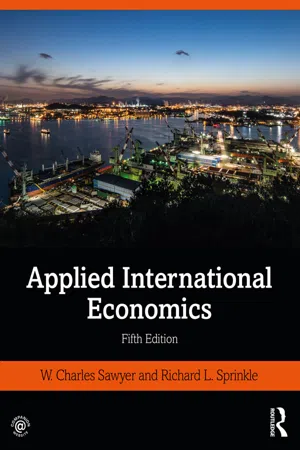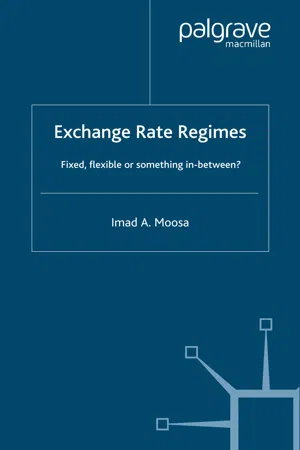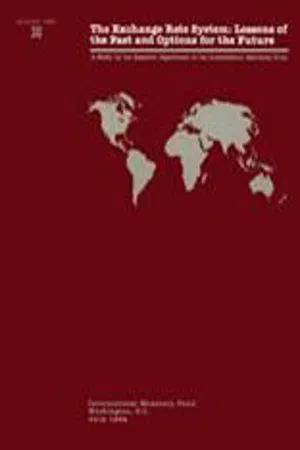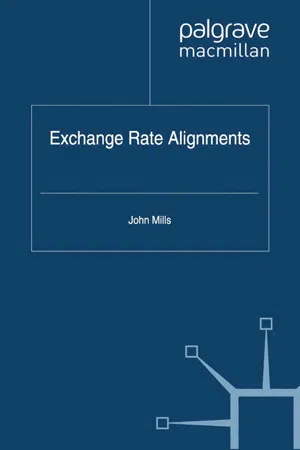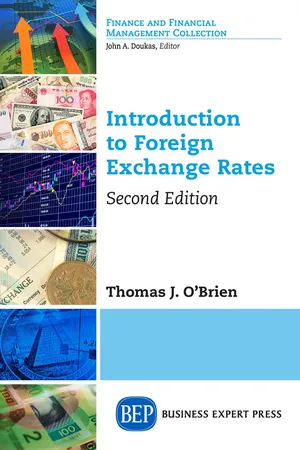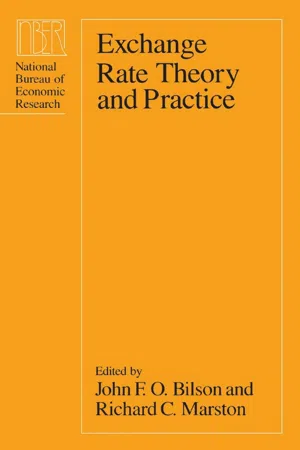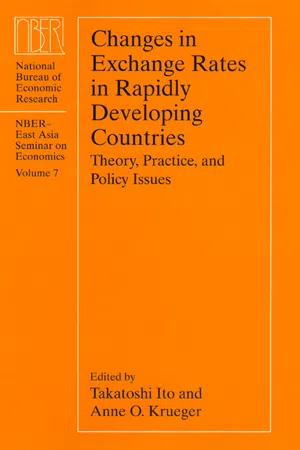Economics
Exchange Rate Change
Exchange rate change refers to the fluctuation in the value of one currency relative to another. It is influenced by various factors such as supply and demand, interest rates, inflation, and geopolitical events. A stronger currency can make imports cheaper but exports more expensive, while a weaker currency can have the opposite effect.
Written by Perlego with AI-assistance
Related key terms
1 of 5
11 Key excerpts on "Exchange Rate Change"
- eBook - ePub
- W. Charles Sawyer, Richard L. Sprinkle(Authors)
- 2020(Publication Date)
- Routledge(Publisher)
CHAPTER 14Exchange rates and their determinationA basic modelThe exchange rate is determined from day to day by supply and demand of home currency in terms of foreign currency. Each transaction is two-sided, and sales are equal to purchases. Any change in the conditions of demand or of supply reflects itself in a change in the exchange rate, and at the ruling rate the balance of payments balances from day to day, or from moment to moment.Joan RobinsonINTRODUCTIONT he international value of a country’s currency has become an inescapable part of the daily flow of economic information. Most of us are aware that a country’s exchange rate is important, but many of us do not have a clear idea of why the exchange rate matters or what causes it to change. As the chapter’s opening quote indicates, the familiar tools of supply and demand analysis can be used to determine a country’s exchange rate. In this chapter, you will learn why the supply and demand model works in analyzing exchange rates—in the same manner, in fact, that it works in analyzing the price of gasoline or pizza, for one dollar or one yen or one gallon of gasoline is indistinguishable from another. By the end of this chapter you should have a good grasp of why exchange rates are important and what factors cause them to change over the long run. Finally, it is obvious to even a casual observer that exchange rates change frequently. These changes, or volatility, are a source of aggravation for individuals, businesses, and governments. The chapter explains what economists know about the effects of exchange rate volatility on international trade and how changes in exchange rates affect the prices of the goods and services we purchase. The final part of the chapter deals with the underlying value of a currency. While the exchange rate we observe in the market often differs from that value, it is very useful to know what that value is.EXCHANGE RATESSuppose that a U.S. importer is purchasing British Jaguars. To purchase the Jaguars, the importer needs to obtain British pounds by exchanging dollars for pounds. The demand for foreign currency is derived from individuals demanding foreign goods and services. This relationship can be applied in reverse. As individuals in the U.K. demand U.S. products, there is an increased demand for dollars. However, this raises the question of how many dollars must be exchanged to obtain the requisite number of pounds, or vice versa? In this example, the relevant exchange rate is the U.S. dollar–U.K. pound exchange rate. In general, the exchange rate is the price of one country’s currency in terms of another. The demand for British pounds relative to the supply of pounds will determine the exchange rate, just as the demand for gasoline relative to the supply of gasoline determines the price of gasoline. Exchange rates fluctuate considerably over time. However, unlike the price of gasoline, changes in the exchange rate are expressed as changes in the value of the domestic country’s currency. An increase in the value of a currency is referred to as appreciation. Analogously, a decline in the value of the currency is referred to as depreciation - eBook - PDF
Exchange Rate Regimes
Fixed, Flexible or Something in Between?
- I. Moosa(Author)
- 2006(Publication Date)
- Palgrave Macmillan(Publisher)
The second problem is that the equilibrium values of the exchange rate are ranked differently by the two countries involved in the bilateral exchange rates. For example, one country may prefer E 1 while the other prefers E 3 . A situation like this could lead to conflict in the economic policies of the two countries. The third problem is that speculation as well as balance of payments disturbances may cause sharp fluctuations in the exchange rate, which lead to an unnecessary and wasteful reallocation of resources. For E 3 E 2 E 1 Q E S D Figure 2.11 Multiple equilibria in the foreign exchange market The Role of the Exchange Rate in the Economy 43 example, if the exchange rate rises slightly above E 1 , speculators will start buying the foreign currency, thinking that it will rise further. The exchange rate will rise beyond the unstable level E 2 , all the way to the stable level E 3 . When it reaches E 3 , speculators sell the foreign currency, causing the exchange rate to fall all the way to E 1 . The effect of a balance of payments disturbance is illustrated in Figure 2.12. A fall in the demand for foreign exchange is represented by a shift in the demand curve, and the equilibrium exchange rate falls from E 1 to E 2 . This big drop is caused by the backward-bending nature of the supply curve. Changes in the exchange rate would be less dramatic under a normal upward-sloping supply curve. The effect of the exchange rate on the current account of the balance of payments emanates from the effect of changes in the exchange rate on prices and, therefore, the demand for domestic and foreign goods (exports and imports). When the exchange rate rises (the domestic currency depreciates), prices of exports in foreign currency terms fall while prices of imports in domestic currency terms rise. - International Monetary Fund(Author)
- 1984(Publication Date)
- INTERNATIONAL MONETARY FUND(Publisher)
This follows from the widely accepted premise that the current exchange rate depends heavily on expectations about the future exchange rate and from the observation that the list of factors affecting these expectations is long and varied—including not only monetary and fiscal policies in the home country but also unexpected policy changes in foreign countries, new political developments abroad, current account “news” in other countries, changes in intervention practices, etc. In short, anything that affects the supply of (or the demand for) assets denominated in the depreciating currency or close substitute currencies could initiate an Exchange Rate Change. Further, even after a decade of floating rates, the possibility of “inefficiencies” in the foreign exchange market that magnify and prolong departures of actual rates from equilibrium rates cannot be ruled out. 43 These inefficiencies may arise from risk aversion combined with legal and regulatory constraints on open foreign exchange positions (i.e., too little stabilizing speculation, as suggested by McKinnon (1976) and Artus and Crockett (1978)), or from a mistaken appraisal of fundamentals by market participants (Dornbusch (1983)), or from the possibility of changes in regime that overwhelm the authorities’ good intentions regarding policymaking (the so-called peso problem), or from speculative “bubbles” that continue to grow larger even in the face of perceived disequilibria because nobody knows when the crash will occur (Blanchard (1979)). Whatever the cause, the point is that weak currencies can be subjected to excessive downward pressure relative to longer-term equilibrium levels. 44 Tobin (1980, pp. 157–58) has provided a good summary of the problem:. . . foreign exchange markets are necessarily adrift without anchors. . . . In these markets, as in other markets for financial instruments, speculation on future prices is the dominating preoccupation of the participants- eBook - ePub
- Javier A. Reyes, W. Charles Sawyer(Authors)
- 2019(Publication Date)
- Routledge(Publisher)
219, it would seem clear what should be happening to the exchange rate. There should be a rapid depreciation associated with falling oil prices and rising inflation. However, the country has chosen not to let this happen. Instead, there is a complicated system of fixed exchange rates, with the central bank rationing the scarce foreign exchange to different sectors of the economy at rates far below the equilibrium exchange rate, while the nominal exchange rate is quietly equilibrating. Over the past ten years, the real exchange rate has appreciated in terms of an index number from around 80 to 320. The rate of appreciation is now almost vertical. Given that the inflation rate in the country is now close to 70 percent and expected to rise further, the appreciation of the real exchange rate is perfectly understandable. This is just an extreme example of the usefulness of the concept of the real exchange rate. With high inflation and a fixed exchange rate, only the real exchange rate can provide information on what the currency is worth. Managed exchange rates At the beginning of this chapter, we covered the total inflows and outflows of money into a country by studying the components of the current account. As we saw, these flows have an effect on the exchange rate. As a consequence, countries have to make decisions about how to manage the exchange rate. However, one has to be careful in defining the term “exchange rate.” Most of the time, we are referring to the nominal exchange rate posted in the market. However, the related concept of the real exchange rate is important. As shown on p. 220, the real exchange rate can change even if the nominal exchange rate does not. The real exchange rate can have an important impact on the volume of trade and on the economy overall. This makes the choice of an exchange-rate regime important. The exchange-rate regime is the system a country uses to manage the exchange rate and the foreign-exchange market - eBook - PDF
- J. Mills(Author)
- 2012(Publication Date)
- Palgrave Macmillan(Publisher)
32 Exchange Rate Alignments to persuade that they have been aiming at precisely the wrong objective for all their working lives. All these sentiments are wrapped up in the widely used rhetoric of exchange rates. When a currency’s value is high, it is strong. When low, it is weak. When it depreciates, its value falls. When it appreciates, it rises. Loaded terms colour everyone’s perceptions. The reality, however, is different. If a country’s currency is too strong, its exports wither, its manufacturing declines, investment and the savings to pay for it fall, living standards for most people stagnate, life chances deteriorate, the foreign exchange and fiscal balances tend to go into deficit, and its rela- tive power and position in the world falls away. This is a terrible price to pay for misconceptions which need to be exposed and which ought not to prevail. Finally, it is surprisingly difficult to disentangle all the existing empir- ical evidence on the impact of exchange rates on economic perform- ance. Table 2.1 sets out some telling statistics, which show how far from being clear-cut and obvious the evidence is. It is clear that between 2000 and 2010 exchange rates and the proportion of the economy devoted to manufacturing were not alone in determining growth rates. Russia and Saudi Arabia did very well out of high oil prices. Greece, Spain and Ireland benefited hugely, for a while at least, from the Eurozone. India, Brazil and the USA were helped by positive demographics. Japan was hindered by a high exchange rate, and Germany by the hangover from unification. Towards the end of the decade, the West was hit much harder than the East by the financial crisis. Disentangling the critical impact of exchange rates is therefore not easy. The really crucial point is that all the other factors which have clearly had an impact on the growth rates in Table 2.1 are largely if not wholly beyond any govern- ment’s capacity to influence. - eBook - ePub
Economics for Investment Decision Makers
Micro, Macro, and International Economics
- Christopher D. Piros, Jerald E. Pinto(Authors)
- 2013(Publication Date)
- Wiley(Publisher)
Foreign exchange markets are crucial for understanding both the functioning of the global economy and the performance of investment portfolios. In this chapter, we have described the diverse array of FX market participants and have introduced some of the basic concepts necessary to understand the structure and functions of these markets. The reader should be able to understand how exchange rates—both spot and forward—are quoted and be able to calculate cross exchange rates and forward rates. We also have described the array of exchange rate regimes that characterize foreign exchange markets globally and how these regimes determine the flexibility of exchange rates, and hence the degree of foreign exchange rate risk that international investments are exposed to. Finally, we have discussed how movements in exchange rates affect international trade flows (imports and exports) and capital flows.The following points, among others, are made in this chapter:- Measured by average daily turnover, the foreign exchange market is by far the largest financial market in the world. It has important effects, either directly or indirectly, on the pricing and flows in all other financial markets.
- There is a wide diversity of global FX market participants that have a wide variety of motives for entering into foreign exchange transactions.
- Individual currencies are usually referred to by standardized three-character codes. These currency codes can also be used to define exchange rates (the price of one currency in terms of another). There are a variety of exchange rate quoting conventions commonly used.
- A direct currency quote takes the domestic currency as the price currency and the foreign currency as the base currency (i.e., Sd/f). An indirect quote uses the domestic currency as the base currency (i.e.,Sf/d). To convert between direct and indirect quotes, the inverse (reciprocal) is used. Professional FX markets use standardized conventions for how the exchange rate for specific currency pairs will be quoted.
- Currencies trade in foreign exchange markets based on nominal exchange rates. An increase in the exchange rate, quoted in indirect terms, means that the domestic currency is appreciating versus the foreign currency, and a decrease in the exchange rate means the domestic currency is depreciating.
- The real exchange rate, defined as the nominal exchange rate multiplied by the ratio of price levels, measures the relative purchasing power of the currencies. An increase in the real exchange rate (Rd/f
- eBook - ePub
- International Monetary Fund(Author)
- 1986(Publication Date)
- INTERNATIONAL MONETARY FUND(Publisher)
IV Effects of Exchange Rate Changes in Industrial Countries
James M. Boughton, Richard D. Haas, Paul R. Masson, and Charles Adams *Two questions arise when large changes occur in exchange rates among the currencies of the major industrial countries. First, what are the effects of those changes on other important economic variables both domestically and abroad, including current account balances, output, prices, and interest rates? Second, what policy reactions, if any, should they entail? These questions are particularly timely in view of the large swings in exchange rates that have characterized the floating-rate era and especially the past five or six years. The 23 percent decline in the nominal effective exchange rate of the U.S. dollar and the 47 percent appreciation of the Japanese yen against the dollar from March 1985 through April 1986, and the decision by the five largest industrial countries in September 1985 to encourage changes in their exchange rates, have added to the urgency of developing a clear understanding of the processes that are involved and of their impact.The scope of this paper is limited in three important ways. First, it deals only with the large industrial countries that have floating exchange rates. To examine the issues that arise for smaller countries with floating rates, as well as for countries with less flexible exchange rate arrangements or fixed rates, would require a different approach from that taken in this paper; available empirical studies pertain almost exclusively to the largest countries. Second, the paper is not concerned with very short-run fluctuations in exchange rates that are reversed within a few months, nor is it concerned with the problems that might arise from any persistent and long-run misalignment of exchange rates. Although the study addresses certain long-run issues at least peripherally, its main emphasis is on the effects that exchange rate movements have over the first few years following a policy change or other disturbance. This limitation is consistent with its empirical and policy-oriented approach. Third, no attempt is made to assess the extent to which exchange rates might in practice have been misaligned. Although it is important to reach a judgment—even if such a judgment must be to some extent subjective—on whether a given currency is undervalued or overvalued in order to determine the appropriate policy responses to currency movements, such judgments are beyond the scope of this paper. - Suranjali Tandon(Author)
- 2019(Publication Date)
- Routledge India(Publisher)
Table 2.1 . The change in foreign exchange reserves, on the other hand, has a two-way causal relationship with the exchange rate. The two-way causality can be attributed to RBI’s response to stabilise the exchange rate during the periods of pronounced depreciation as well as the adverse movements in overall balance of payments position. Therefore, changes in the exchange rate tend to influence the changes in foreign exchange reserves that are used by the RBI to intervene in the market to stabilise the value of the rupee. This, in turn, has a direct impact on the value of the exchange rate.Findings that exchange rate movements result from net portfolio flows, whereas merchandise trade has no causal relationship, are the first step in the detailed analysis that this book proposes to undertake. The exchange rate is driven by certain factors such as the portfolio investment, is the consideration for rate management, and is therefore useful for design of policy. However, the focal point of this research is that, with the changes in exchange rate, a dynamic process of adjustment, in the external account and the economy, may be set in motion. Theoretically, two kinds of adjustment ensue – price and quantity. These have been debated widely, and evidence has not been consistently presented for India. Therefore, from here on, detailed evidence will be presented on price movement and quantity adjustments in response to exchange rate movements.Price adjustments in India: theory and evidence
In theory, the changes in the nominal exchange rate lead to an accommodating change in relative prices. On this basis, the purchasing power theory or the law of one price posits a constant real exchange rate. However, price rigidities in markets and productivity differentials among other factors could delay or negate the process of adjustment. For the period post liberalisation – that is, July 1994 to June 2014 – strong co-movement in the nominal and real exchange rate is observed between the rate of change (month-on-month) in real and nominal effective exchange rates. However, such co-movement attenuated for the period August 2012 to April 2013, when the real exchange rate appreciated despite the nominal exchange rate depreciation. The main reason for this divergence was a contemporaneous decline in global price levels and a rise in domestic prices in India (Bhagwati et al., 2015).- Thomas J. O'Brien(Author)
- 2016(Publication Date)
- Business Expert Press(Publisher)
CHAPTER 2 Impact of Foreign Exchange Rate ChangesAlthough spot foreign exchange (FX) rates at any moment are known and observable, one does not know ahead of time what future spot FX rates will be. Many try to predict and speculate, but there is always uncertainty about where FX rates will go in the future. Some FX rates are more volatile than others, depending on fundamental supply and demand and whether government policies tend to stabilize or destabilize. This chapter covers some issues related to FX volatility.Central Banks and Balance of PaymentsIn addition to retail and interbank elements, central banks are important FX market participants. A central bank has an unlimited supply of its own economy’s currency. In addition, a central bank maintains balances of foreign currency reserves (or FX reserves) of other currencies, obtained over time through transactions in the interbank market. In their FX reserves, central banks like to hold currencies that hold value. In 2012, the most prominent reserve currencies were (1) the U.S. dollar (62 percent), (2) the euro (25 percent), (3) the British pound (4 percent), and (4) the Japanese yen (4 percent).To see an example of routine interaction between central banks and the private FX market, say the Bank of England has sold British pounds to Crown Materials’ U.S. bank for the U.S. dollars sent to Crown by Belmont. The Bank of England can either hold the U.S. dollars as FX reserves, or trade the U.S. dollars back to the Fed for some of the Fed’s existing FX reserves of British pounds (or for gold or other currency). If Belmont had acquired British pounds from its U.S. bank, which in turn had acquired the pounds from the Fed, the Fed would then be holding fewer British pounds in its FX reserves. If the Fed thinks that the new inventory level of British pounds is too low, the Fed can buy more pounds in the interbank market, or from the Bank of England using gold or U.S. dollars or, for that matter, any other country’s currency that the Fed is holding as FX reserves. If either of the central banks is in the transaction, then there is an increase in the British pound money supply- eBook - PDF
- John F. Bilson, Richard C. Marston, John F. Bilson, Richard C. Marston(Authors)
- 2007(Publication Date)
- University of Chicago Press(Publisher)
Nominal apprecia- tion of the exchange rate in the face of external price increases could also be consistent with private market behavior where agents perceive the de- terioration of the terms of trade as a permanent improvement in international competitiveness. More often, however, at least among smaller European countries, increases in foreign prices have been transmitted to domestic prices through substitution and income effects in consumption or production. This process could even be accompanied by exchange rate depreciation if the rise of internal prices exceeds that of traded goods.4 Finally, changes in nominal exchange rates among hard currencies have led to changes in effec- tive exchange rates which have in turn been transmitted to domestic prices and, in the case of countries with market power, to the foreign currency price of export^.^ Thus real exchange rate movements reflect different economic processes which result from the interaction of private market participants and policy authorities. Even in those cases where real exchange rates have remained roughly constant, it is interesting to analyze the economic forces behind the process of real exchange rate determination. Such analysis can highlight the effectiveness of exchange rate policy and can illuminate the fundamental reasons for alternative targets in the exercise of exchange rate policy. Thus in a country where nominal exchange rate devaluation quickly raises domes- tic prices by the full extent of the devaluation, an active exchange rate pol- icy can only become an instrument of anti-inflation policy rather than bal- ance of payments adjustment. Alternatively, if the speed of adjustment is low, nominal exchange rate policy can potentially become a useful instru- ment of external balance. - eBook - PDF
Changes in Exchange Rates in Rapidly Developing Countries
Theory, Practice, and Policy Issues
- Takatoshi Ito, Anne O. Krueger, Takatoshi Ito, Anne O. Krueger(Authors)
- 2007(Publication Date)
- University of Chicago Press(Publisher)
If the home currency accidentally appreciates, in- dependent of the fundamentals, the residents will find that imported goods are now cheaper-and this will exert downward pressure on the domestic price level. Causality is reversed from the previous case: the exchange rate move- ment is causal to the changes in the fundamentals. For instance, empirical stud- ies by Helkie and Hooper (1988) and Ohno (1990) treat the exchange rate as an explanatory variable that determines domestic prices. In addition, practi- cally all contributions to the literature of exchange rate pass-through treat the exchange rate as an exogenous shock. Because the exchange rate is an asset price dominated by expectations, it could also anticipate future changes in the fundamental variables and move first. Then true causality runs from Japanese monetary policy to the yen-dollar rate-although the time sequence is reversed from the traditional Cassel case. In sum, there are three alternative and mutually exclusive interpretations of the fact that the nominal exchange rate and relative national price levels move in the same direction in the long run: Hypothesis 1. The exchange rate is an “adjusting variable” that passively accommodates changes in the fundamentals (prices, monetary policy, etc.). In this case, the flexibility of the exchange rate-despite short-term volatility-contributes to economic adjustment in the medium to long run. Causality runs from the fundamentals to the exchange rate. Hypothesis 2. The exchange rate is a “forward-looking variable” that antici- pates future autonomous changes in the fundamentals. In this case, the true causality is from the fundamentals to the exchange rate, but the move- ment of the exchange rate precedes the fundamentals in the observed time-series sequence. 358 Ronald I. McKinnon, Kenichi Ohno, and Kazuko Shirono Hypothesis 3.
Index pages curate the most relevant extracts from our library of academic textbooks. They’ve been created using an in-house natural language model (NLM), each adding context and meaning to key research topics.
